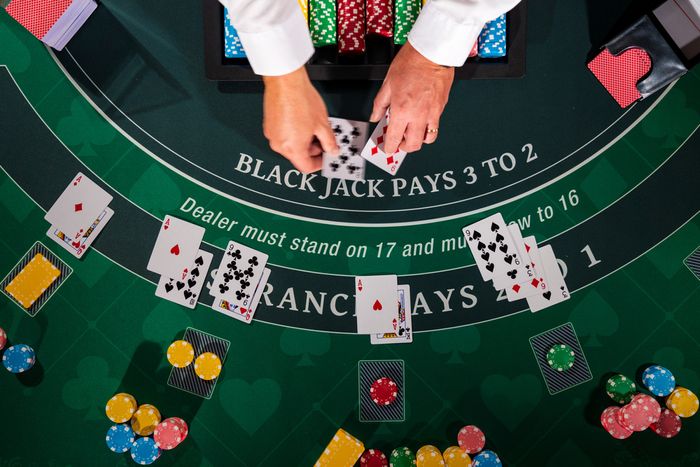Basic Rules of Blackjack Explained for Beginners
There are many variations of blackjack, each with their own rules and bonuses based on the popular casino card game.
Published July 3, 2024

Blackjack is a classic casino game that continues to captivate players worldwide with its strategic gameplay and relatively low house edge compared to other casino games. While the rules are straightforward, mastering blackjack takes practice and an understanding of key concepts.
This guide provides a solid foundation for beginners, covering the game's essential rules, strategic decisions, and practical aspects to improve your chances of winning.
» Master the nuances of blackjack and improve your game strategy at live blackjack tables
The Goal of Blackjack and the Value of Cards
The fundamental objective of blackjack is to beat the dealer by having a hand value closer to 21 without exceeding it. Players win if their hand is higher than the dealer's without going over 21, which is referred to as "busting".
Understanding the Cards
- Number Cards (2-10): Their value is the number on the card.
- Face Cards (Jack, Queen, King): These all have a value of 10.
- Aces: These can count as either 1 or 11. For example, an ace and 6 could be counted as either 7 or 17, giving you the chance to potentially increase your score without immediately busting.
Understanding these values is essential for making strategic decisions during the game, as they affect how players approach their hands and plan their next moves.
Player and Dealer Actions and Strategies
During their turn, players can take various actions to try and reach that value of 21:
- Hit: Draw another card. Best when your hand is low and unlikely to bust but can also be used on relatively higher values if you're feeling confident.
- Stand: Keep your current hand. Ideal when you have a strong value (19-21) or risk busting with another card (15-18).
- Double down: Double your bet and receive one more card. Use when you have a strong hand like 10 or 11.
- Split: Separate your hand into two if you have a pair, keeping your original bet on one card and placing an equal bet on the second. This allows you to essentially play two hands at the same time, increasing your chances of a win. Works best with pairs like aces or 8s.
- Surrender: Forfeit half your bet to end the hand and minimize your loss. Use when you have a very weak hand against a strong dealer card.
The dealer manages the game flow and play according to strict house rules. In most casinos, dealers must hit until their hand totals 17 or higher and stand on all 17s, including a "soft" 17 (ace and 6).
These rules eliminate dealer discretion, ensuring a consistent game experience. The dealer's actions influence player strategy as they can anticipate the dealer's moves and adjust their decisions accordingly.
The Glossary of Blackjack Terms
- Blackjack: An ace with any 10-value card (Jack, Queen, or King) is called a "natural blackjack". In this case, you win automatically (unless the dealer also scores a blackjack) and are paid 1.5:1 instead of the usual 1:1.
- Hard hand: This happens when your hand contains an ace that must be counted as 1, or you have no aces and the value is fixed.
- House edge: The statistical advantage the casino has over the players, typically around 0.5% with optimal play. The house edge in blackjack is comparatively lower than other casino games.
- Insurance: A side bet is offered when the dealer shows an ace, paying 2:1 if the dealer has a blackjack.
- Push: A tie between the player and dealer, resulting in no win or loss for either side.
- Soft hand: This happens when your hand contains an ace that could be counted as 1 or 11.
» Put these terminologies into action by playing live blackjack
The Flow of a Typical Blackjack Round
- Place bets
- Both your cards are dealt face up, while only one of the dealer's cards is face up with the other face down
- Players decide to hit (as many times as they request), stand, double down, or split based on their hands
- The dealer reveals their face-down card and hits or stands depending on the individual casino's rules
- Payouts are granted after the results have been resolved
How Do Blackjack Payouts Work?
In blackjack, standard wins are paid 1:1, meaning if you bet $10, you win an additional $10, making your total payout $20.
A "blackjack" is a special case where the payout is higher, at 1.5:1. So, for a $100 bet, you'll win $150, with your total payout being $250. This reflects the rarity and advantage of achieving a natural 21 with your first two cards.
However, it's important to note that if both the player and the dealer score a blackjack, the game results in a push. This rule helps to maintain a fair balance in the game.
Playing blackjack online for cash adapts these traditional rules to the digital landscape. Additionally, online blackjack games might offer additional features like side bets or insurance, which can affect payout ratios.
Tricky Situations and Strategies Encountered in Blackjack
When the Dealer Shows an Ace
Facing a dealer's ace presents a tough situation. The dealer will offer insurance if they have a blackjack. Although it might seem appealing, taking insurance isn't statistically advisable here as it boosts the house edge.
Additionally, an ace is a strong dealer card as they could likely achieve a hand close to 21. You should exercise caution:
- On a 16 or lower: hit or surrender (based on the cards of other players)
- On a 17 or higher: Stand
Double 8s
A hard 16 is one of the worst in blackjack, as it has a high probability of busting if you hit and is likely to lose if you stand. Consider splitting the 8s to turn a weak hand into two potentially stronger ones.
When you split a hand, you must place an additional bet equal to your original wager. Even though this strategy involves higher stakes, it improves your chances compared to playing a single 16 and is particularly beneficial against dealer upcards of 9, 10, or ace.
Drawing a Total of 10 or 11
When you have a total of 10 or 11 due to two lower-value cards, the probability of drawing a higher card and ending with a strong hand is relatively higher. So what should you do?
Consider the dealer's upcard:
- If they show a low card (2-6), they are more likely to bust, making it a favorable situation to double down.
- If they show a high card (7-10 or ace), proceed cautiously as their chances of making a strong hand are higher.
Playing a Soft 17
A soft 17 should usually be played aggressively because the risk of busting is much lower. If you hit, any value of 4 or lower puts you in a strong position. Anything higher, and you can switch the ace's value to 1 and essentially get a second chance at a stronger hand.
Playing a Hard 12-16
Deciding whether to hit or stand on a hard 12-16 is one of the toughest decisions. These hands have a high risk of busting if you hit, but standing leaves you with a weak total that is likely to lose. What should you do?
Consider the dealer's upcard:
- If they show a low card (2-6), they have a higher chance of busting, so standing on 12-16 is a safer option.
- If they show a high card (7-10 or ace), hitting might be the better choice despite the risk as it gives you a chance to compete.
Different Variations of Blackjack Rules
- European blackjack: Dealt with 2 decks, the dealer does not check for blackjack until after the player has completed their hand.
- Spanish 21: All 10s are removed from the deck and offers more liberal playing rules such as re-splitting, late surrender even after doubling down, and even unique bonuses for Blazing 7s and 5-card 21s.
- Blackjack switch: Players receive two hands instead of one and have the option to switch the top two cards between hands for optimal results.
- Single-deck blackjack: Played with only one deck, this variation significantly reduces the house edge but often has different payout structures.
- Double exposure blackjack: Both of the dealer's cards are exposed, but players lose ties and blackjack pays even money.
- Multi-hand blackjack: Players can play multiple hands at the same time, increasing the game's pace and potential winnings or losses.
- Atlantic City blackjack: Uses 8 decks and allows players to surrender late, double down on any two cards, and split up to three hands.
- Vegas Strip blackjack: Typically played with 4 decks, this variant allows doubling down on any two cards after splitting.
Get Started With Blackjack Today
As a beginner, you should always practice responsible gaming by being aware of bankroll management, setting loss limits, and understanding the psychological aspects of gambling. It's important to approach blackjack as a source of entertainment from the thrill of the game rather than a reliable way to make money.
Learning advanced strategies like card counting can be beneficial but requires significant practice and discipline.













